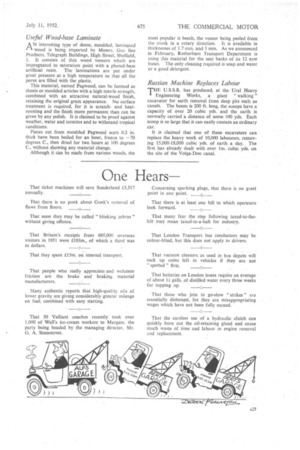Passing Comments
Page 28

Page 29

If you've noticed an error in this article please click here to report it so we can fix it.
Flaw Detection By Magnetic Ink
ONE of the most popular methods of detecting flaws in iron and steel parts, provided that these are on or close to the surface, is the magnetic, used in conjunction with a special " ink " containing a powder affected by magnetism. The principle is that. magnetic polarization occurs at any break in the continuity of the metal, and the particles in the ink collect at this point, whether it be an actual crack or other defect.
' Much of the efficiency of the method depends, however, upon tha quality of the ink employed. The powder must remain in suspension for comparatively long periods and must not have a tendency to cake, whilst the choice of the right colour for the work in hand is important. The actual grades vary according to the powder content. Some operators like a heavy indication, others prefer one which will not obscure fine details.
A26 In this connection, Manchester Oil Refinery (Sales), Ltd., Twining Road, Trafford Park, Manchester, 17, is manufacturing a complete range of flaw-detection inks, under the name of Supramor. These can be applied in various ways, by pouring from a non-metallic ladle, spraying or dipping magnetized test pieces into a bath of the ink.
As You Were
qHEFFIELD has decided that cheerfulness is pre ferable to economy. The city council resolved, in April, to abandon the traditional blue and cream livery of the transport department, and to save about £2,000 a year on the buses and £2,500 on the trams by painting them green. This change caused great controversy and the council has now decided that a small saving it not worth the dismal effect produced by a darker colour.
Useful Wood-base Laminate
A N interesting type of dense, moulded, laminated -r-1 wood is being imported by Messrs. Gee Bee Products, Telegraph Buildings, High Street, Sheffield, 1. It consists of thin wood veneers which are impregnated to saturation point with a phenol-base artificial resin. The laminations are put under great pressure at a high temperature so that all the pores are filled with the plastic.
This material, named Pagwood, can be formed as sheets or moulded articles with a high tensile strength, combined with an attractive natural-wood finish, retaining the original grain appearance. No surface treatment is required, for it is scratchand heatresisting and the finish more permanent than can be given by any polish. It is claimed to be proof against weather, water and termites and to withstand tropical conditions.
Pieces cut from moulded Pagwood seats 0.2 in. thick have been boiled for an hour, frozen to —70 degrees C., then dried for two hours at 100 degrees C., without showing any material change.
Although it can be made from various woods, the most popular is beech, the veneer being peeled from the trunk in a rotary direction. It is available in thicknesses of 1.7 mm. and 3 mm. As we announced in February, Rotherham Transport Department is using this material for the seat backs of its 12. new buses. The only cleaning required is soap and water or a good detergent.
Russian Machine Replaces Labour
THE U.S.S.R. has produced, at the Ural Heavy Engineering Works, a giant " walking" excavator for earth removal from, deep Pits such as canals. The boom is 200 ft. long, the scoops have a capacity of over 20 cubic yds. and the earth is normally carried a distance of some 100 yds. Each scoop is so large that it can easily contain an ordinary car.
It is claimed that one of these excavators can replace the heavy work of 10,000 labourers, removing 15,000-18,000 cubic yds. of earth a day. The first has already dealt with over lm. cubic yds. on the site of the Volga-Don canal.




















































































